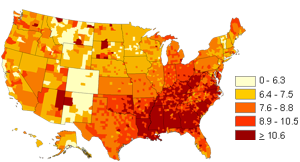Artificial Pancreas Simulation Study
This lab is a tutorial for designing an artificial pancreas for a Type-I diabetic. A Type-I diabetic has no insulin production in the pancreas. Insulin production in the pancreas is used to regulate a person’s blood glucose level. When that natural production does not exist, glucose is monitored at regular intervals and insulin is injected as needed. With the recent development of continuous blood glucose monitors and the established success of continuous insulin pumps, it is now possible to create a controller that automatically regulates blood glucose by adjusting the injection rate of insulin. This development is needed because of the increased rates of diabetes within the U.S. as tracked by the Center for Disease Control (CDC). The incidence of diabetes mellitus is shown for the year 2008 with predictions for average rates of 33% by 2050 if the trend continues. Currently 8-9% or 26 million Americans are affected by this condition with yearly direct medical costs of $116 billion and even higher indirect costs.

The set point for blood glucose concentration is expected to remain within a specified range that is typical of a healthy individual. A typical range for a healthy individual is between 64 and 104 mg/dL (3.6 and 5.8 mmol/L) with a target of 80 mg/dL. Blood glucose values that are out of range are undesirable but values that are too low are much more serious and can lead to hospitalization or death if left untreated.
The insulin pump is a continuous injection into the person’s body. It can deliver flow rates between 0.0 and 10.0 mU/min with a typical base value of 3.0 mU/min. The controller must restrict values of the flow to this range during the controller testing although it is typical with these devices to allow small one-time injections when needed.
As a first step, perform the necessary open loop dynamic modeling studies to determine a first order linear model which describes process operation near the design operation conditions (use diabetes_1step.slx Simulink model to generate step response data). Report values of Kp and taup.

This lab reinforces principles of system dynamics, estimation, and model predictive control. In particular, this lab reinforces:
- The difference between manual and automatic control
- Step tests to generate dynamic data for empirical modeling
- Dynamic modeling with first principles
- Tune a proportional integral derivative controller
- Tune a model predictive controller
The three important elements for this simulation lab are the measurement device (continuous glucose sensor), an actuator (insulin pump), and capability to perform computerized control (MATLAB/Simulink). At maximum output the pump delivers 10 mU/min of insulin. The desired target for blood glucose is between 68 and 104 mg/dL. Design a controller to manipulate the insulin pump flow rate to maintain acceptable blood glucose levels with meal disturbances.

